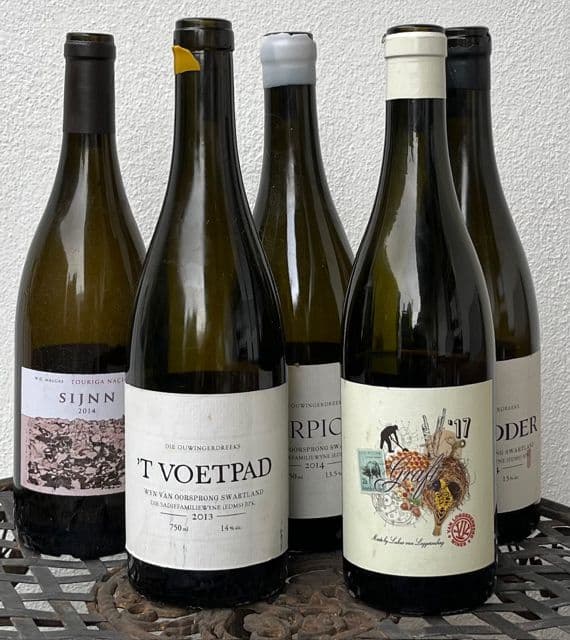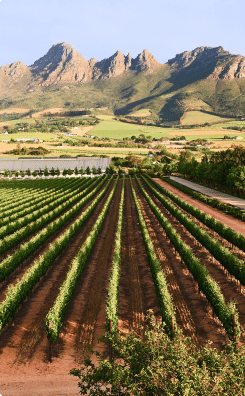Tim James: Middle-aged new wave producers and some middle-aged wines
By Tim James, 20 November 2023

4

Browsing through Strauss’s latest online wine auction, titled “Young gun and new wave producers”, I was struck first – once again – by how important chenin blanc has been to the Cape wine revolution. The grape is hugely over-represented on the auction, because there are so many good or potentially good vineyards around for those who look for them: if you’re keen and ambitious, even if you’re not rich you can find some fine chenin grapes and show your winemaking skills. And get rich if you’re lucky as well as good.
Second thought was that “new wave” refers to a movement that is hardly new any more – though I can’t think of a better description for something we all understand. It’s a pretty old new wave, though continuing to generate energy, which is what counts and keeps it wave-like. As to “Young Guns”, well, I presume the auctioneer isn’t thinking of most of the producers in this auction – some are in their 50s and the majority wouldn’t even make it into the generous ANC Youth League. I remember when Wine Cellar in Cape Town used to have annual big rah-rah tastings with selected “Young Guns” and their wines. The only one I went to, I think, included Peter-Allan Finlayson with Crystallum (about 2015?) – which is, yes, a new wave-ish label (fresh, avoiding lots of new oak) but he’ll have to now settle for that category on this sale, and leave Young Gun honours to, I suppose, the likes of André Bruyns (City on a Hill) and Bernhard Bredell (Scions of Sinai), Charla Haasbroek and not a whole lot of others. And even they are not really so young….
Quite a lot of the wines offered are still flushed with youth, however. The originators of the Strauss wine auction business (during the early Covid time) are no doubt proud that they’ve done a lot towards building a secondary market for South African wine. The majority of wines in the current auction range from 2014 to 2019 – with a bit of Boekenhoutskloof Semillon 2004 and a bottle of Sadie Palladius 2003 (I’d be much more nervous about buying the latter than the former) pretty lonely oldies. Alheit and Sadie are overwhelmingly the best represented in the line-up. That’s a bit of a pity, but these are the “new wave” producers that have the best record at auctions, and have made a lot of money for sellers – and doubtless given a lot of interest to others who hadn’t caught on in time, or who simply prefer and can afford to buy mature wine (I hope there haven’t been too many disappointments).
I confess, though, I don’t really understand some buyers. Is it really sensible, I wonder, to buy Rall White 2019 for about R850 a bottle (at the auctioneer’s low estimate; they think it could well go higher) when you can pop out to a shop and buy the 2022 for R350? But perhaps it’ll reveal to someone how useful those few maturing years have been, and they’ll get wise and buy the current vintage and keep it a few years, saving a lot of money (and for three years’ maturation, I really don’t think that perfect storage conditions are important).
I’d guess that most of the whites on the auction in the middle of the 2014-2019 window should be drinking just about perfectly now, and probably the earlier vintages too. I always conservatively recommend that five years is probably about right for most Cape whites, though a smallish number will show the benefit in complexity and structure of more years, if well stored.
If that’s what I recommend, I certainly don’t always follow my advice, and occasionally regret it, while occasionally being pleased that I hadn’t. But I have quite a bit of well-stored white wine that I now don’t have complete confidence in; this summer I intend to catch up a bit with the older stuff. I’ve started the process, and reporting now on a few middle-aged and a few almost elderly bottles – not all white – that I’ve had over the past month might be of interest to others.
Some Sadies first. When I opened Skerpioen 2014 for a friend over lunch, we both rather regretted not having it a few years earlier; it just seemed a little more tired than this vibrant wine should be; still a good drink, but without having gained much to compensate. Interestingly, a day later, I got much more excited about it, which is quite the opposite of what should have happened. So, I need to try another bottle soon. With another lunch-friend more recently, we had ‘T Voetpad 2013. No doubt about this: it was a splendid bottle perhaps at the peak of its great potential, having gained in both harmony and complexity. No hurry with any other bottles that I hope I have. On the same occasion, wanting something red, we had Pofadder 2014. I’m still convinced that even seriously intended cinsault is at its best when blended with sterner stuff, but this bottle was cruising along happily, showing both charm and a touch of profoundity, having probably gained a bit in volume-substance and integration over the years. A great pleasure. I doubt if it’s going anywhere in particular, but certainly no need to drink up.
Another 2014 red that gave me particular pleasure, partly because I really wasn’t sure what to expect, was Sijnn Touriga Nacional. It was lovely and fresh, still quite juicily, full-fruitedly youthful, but the variety’s tannins had soften and lengthened and harmonised in a totally satisfactory whole. At the launch of the recent Sijnn reds, the 2019 Touriga was still impossibly young, though also with an admirable future, I’m confident. It’s a great grape, this, and I wish the new wave made more of it. Incidentally, one of the best things about Sijnn is the marvellous young-gun/new-wave energy and adventurousness that David Trafford rather unexpectedly revealed when he founded it, and the support he gives to his excellent winemaker, Charla Haasbroek whose approach (specially the earlier picking) is probably not always entirely sympathetic to his own (I’m guessing there). Incidentally, spurred on by this 2014, I opened a Sijnn Red 2015, which includes touriga in the blend and was unsurprisingly that bit more complex and interesting, and deserving of longer in bottle.
The last red I want to mention is one which was made by someone who was very much a Young Gun, confidently surfing the new wave, when he made it in 2017, but now shifting out of that category. The maiden vintage of Van Loggerenberg Graft had 55% cinsault along with syrah, but became pure Polkadraai syrah the following year. That was unquestionably the right decision – the greatest things about this gorgeous 2017 are the syrah bits, that dry spiciness and subtle but firm tannin. The cinsault does add some lovely sweetness of fruit and it is an excellent wine. We’re still not sure about the longer-term developmental possibilities of some of the lighter-styled wines, but this – not really light, at 13.5% alcohol – is certainly still showing well.
Tiny quantities made, so I suspect it won’t get much of a showing on auctions to come – but worth looking out for. The current Strauss auction, by the way, is taking online bids until 27 November.
- Tim James is one of South Africa’s leading wine commentators, contributing to various local and international wine publications. He is a taster (and associate editor) for Platter’s. His book Wines of South Africa – Tradition and Revolution appeared in 2013.







Ashley Westaway | 28 October 2024
Hi Tim… Better later than never. The Grahamstown Wine Tasting Group (GWTG) uses a 20-point scoring system. The highest rated wines tasted by the group this year were the Skurfberg 2016 (17,4) and T-Voetpad 2016 (17,1). I recently hosted a mini vertical Pofadder tasting for a smaller group. We tasted the 2014 (which you commented on in this article), 2015 and 2016. All three were delicious. The 2014 was charming, the 2015 perfectly balanced, and the 2016 riveting.
Ashley Westaway | 5 January 2024
Greetings Tim. The wine club tasting will happen next month. But I’ve sampled two Sadie 2012s over this holiday period. See notes below.
Skurfberg 2012: There is a preponderance of ripe stone fruit on the nose; sweet peaches, nectarines. There are also now distinct honey notes developing. The nose is very full, but the sweet fruit is beautifully balanced by freshness. The nose reflects the heat of the northern Swartland Summer Sun. Minerality dominates the palate and affords the wine a certain modesty. Stone fruit is abundant, but held in check by both minerality and acidity. The finish is long and so so satisfying. The tasting again confirms the Skurfberg as one of the finest sites in the world for chenin.
Skerpioen 2012: Drinking superbly. It has developed lovely tropical notes and flavors, especially spanspek melon. The wine is still very primary and all its parts are held together with fantastic acidity and salinity. There’s strong continuity between nose and palate; the mouth feel is excellent and the finish very long. At this point, twelve years after bottling, it seems that the wine could age forever.
Tim James | 20 November 2023
Thanks Ashley. Please do report back. We all need all the reports we can get of how these new wines are ageing.
Ashley Westaway | 20 November 2023
Greetings Tim. I always enjoy and benefit from your reports on tastings of aged wines (esp Sadies). Early in the new year, I’ll be pouring some Sadies and other wines for my wine club (in Makhanda/ Grahamstown). Some on my provisional list are: 2012 Pofadder and Bellevue Pinotage; 2016 Skurfberg , T-Voetpad and Laing Groendruif; 2018 Skerpieon and Bloemcool Ploegperd; and 2021 Soldaat and Lourens Family Lua Ilse. I’ll report on the tasting in February next year.